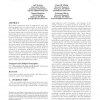Free Online Productivity Tools
i2Speak
i2Symbol
i2OCR
iTex2Img
iWeb2Print
iWeb2Shot
i2Type
iPdf2Split
iPdf2Merge
i2Bopomofo
i2Arabic
i2Style
i2Image
i2PDF
iLatex2Rtf
Sci2ools
SIGIR
2012
ACM
2012
ACM
Improving searcher models using mouse cursor activity
Web search components such as ranking and query suggestions analyze the user data provided in query and click logs. While this data is easy to collect and provides information about user behavior, it omits user interactions with the search engine that do not hit the server; these logs omit search data such as users’ cursor movements. Just as clicks provide signals for relevance in search results, cursor hovering and scrolling can be additional implicit signals. In this work, we demonstrate a technique to extend models of the user’s search result examination state to infer document relevance. We start by exploring recorded user interactions with the search results, both qualitatively and quantitatively. We find that cursor hovering and scrolling are signals telling us which search results were examined, and we use these interactions to reveal latent variables in searcher models to more accurately compute document attractiveness and satisfaction. Accuracy is evaluated by computing ...
Document Relevance | Information Storage And Retrieval | Information Technology | Latent Variables | SIGIR 2012 |
Related Content
| Added | 28 Sep 2012 |
| Updated | 28 Sep 2012 |
| Type | Journal |
| Year | 2012 |
| Where | SIGIR |
| Authors | Jeff Huang, Ryen W. White, Georg Buscher, Kuansan Wang |
Comments (0)

